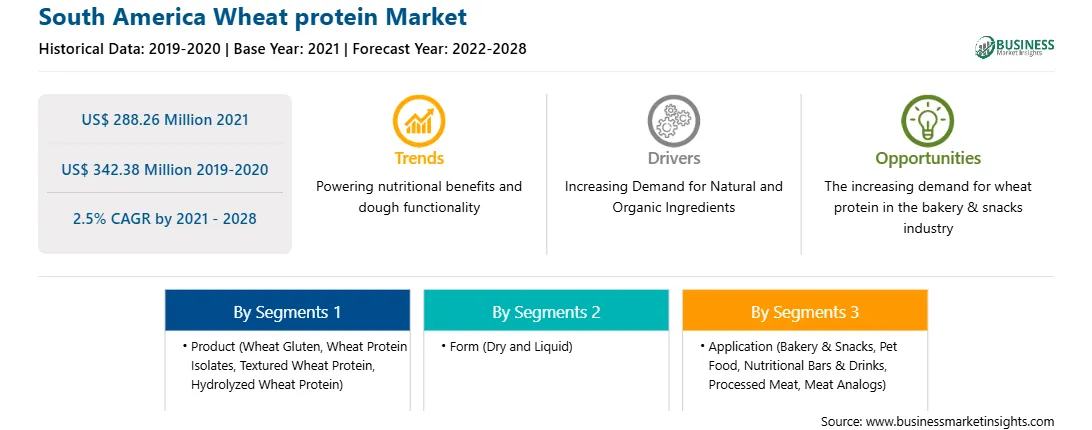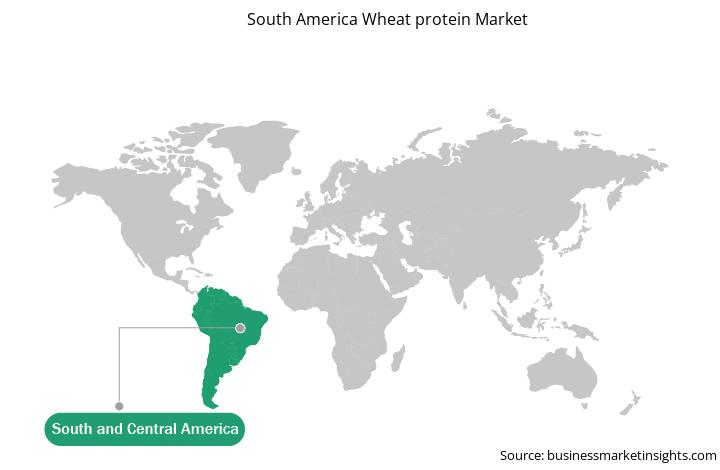Meat analogs are food products produced to mimic meat products' flavor, appearance, and texture. Meat analogs are raising the interest of various consumers looking for indulgent, healthy, low environmental impact, cost-effective, ethical, and new food products. In recent years, the consumption of meat analogs has grown for varied reasons such as health concerns, personal beliefs, and social causes. Textured plant-based proteins, primarily soy, wheat, and their combinations are used to improve the mouthfeel and simulate the "original meat texture" in the meat analogs, owing to the texture generated when they are hydrated during the cooking process. The textured wheat protein offers a meat-like texture and is consequently used for partial or complete meat replacement. Textured wheat protein has an excellent neutral taste and stable, hydrated texture, making it suitable for various applications, especially meat analogs. Besides, textured wheat proteins play a significant role in the formulation of meat analogs because they offer a variety of shape, size, and color offerings, ease of formulation, and nutritional benefits (high protein and no cholesterol). Thus, the growing vegan population, coupled with increasing demand for meat analogs, is the key factor expected to create lucrative growth opportunities for the wheat protein market during the forecast period.
Brazil reported the highest number of COVID-19 cases, followed by Argentina, Peru, Chile, and Ecuador among others. The government of SAM has taken an array of actions to protect its citizens and combat the spread of the COVID-19 virus through lockdowns, trade bans, and travel restrictions. This may have a direct impact on the growth of the wheat protein market due to significant disruptions in terms of sourcing of raw materials from suppliers as well as temporary closures of the manufacturing base due to indefinite lockdowns and temporary quarantines. As there have been relaxations in the lockdown, there has been an increase in demand for healthy bakery items and plant-based protein, which is increasing the demand for the wheat protein market. Along with this, an increase in demand for meat alternatives in countries such as Brazil is driving the wheat protein market in SAM.
With the new features and technologies, vendors can attract new customers and expand their footprints in emerging markets. This factor is likely to drive the SAM wheat protein market. The SAM wheat protein market is expected to grow at a good CAGR during the forecast period.
Strategic insights for the South America Wheat protein provides data-driven analysis of the industry landscape, including current trends, key players, and regional nuances. These insights offer actionable recommendations, enabling readers to differentiate themselves from competitors by identifying untapped segments or developing unique value propositions. Leveraging data analytics, these insights help industry players anticipate the market shifts, whether investors, manufacturers, or other stakeholders. A future-oriented perspective is essential, helping stakeholders anticipate market shifts and position themselves for long-term success in this dynamic region. Ultimately, effective strategic insights empower readers to make informed decisions that drive profitability and achieve their business objectives within the market.

| Report Attribute | Details |
|---|---|
| Market size in 2021 | US$ 288.26 Million |
| Market Size by 2028 | US$ 342.38 Million |
| Global CAGR (2021 - 2028) | 2.5% |
| Historical Data | 2019-2020 |
| Forecast period | 2022-2028 |
| Segments Covered |
By Product
|
| Regions and Countries Covered | South and Central America
|
| Market leaders and key company profiles |
The geographic scope of the South America Wheat protein refers to the specific areas in which a business operates and competes. Understanding local distinctions, such as diverse consumer preferences (e.g., demand for specific plug types or battery backup durations), varying economic conditions, and regulatory environments, is crucial for tailoring strategies to specific markets. Businesses can expand their reach by identifying underserved areas or adapting their offerings to meet local demands. A clear market focus allows for more effective resource allocation, targeted marketing campaigns, and better positioning against local competitors, ultimately driving growth in those targeted areas.

The South America Wheat protein Market is valued at US$ 288.26 Million in 2021, it is projected to reach US$ 342.38 Million by 2028.
As per our report South America Wheat protein Market, the market size is valued at US$ 288.26 Million in 2021, projecting it to reach US$ 342.38 Million by 2028. This translates to a CAGR of approximately 2.5% during the forecast period.
The South America Wheat protein Market report typically cover these key segments-
The historic period, base year, and forecast period can vary slightly depending on the specific market research report. However, for the South America Wheat protein Market report:
The South America Wheat protein Market is populated by several key players, each contributing to its growth and innovation. Some of the major players include:
The South America Wheat protein Market report is valuable for diverse stakeholders, including:
Essentially, anyone involved in or considering involvement in the South America Wheat protein Market value chain can benefit from the information contained in a comprehensive market report.